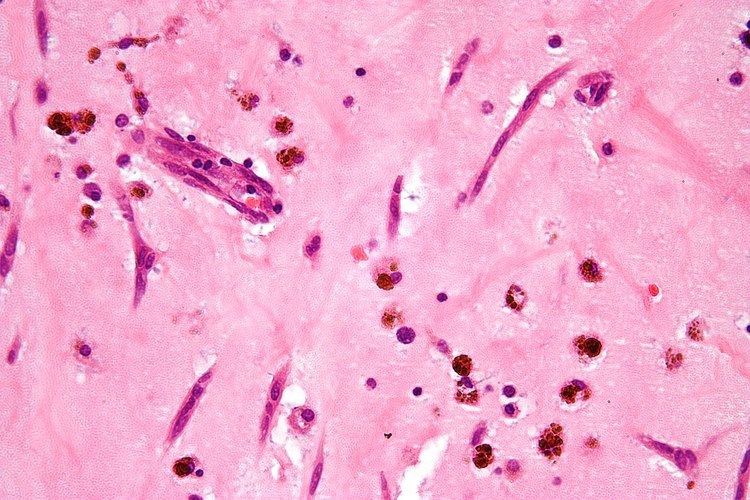DiseasesDB 1075 | MedlinePlus 007273 | |
 | ||
An atrial myxoma is a benign tumor of the heart, most commonly found within the left and then the right atria on the interatrial septum.
Contents
Causes
Myxomas are the most common type of primary heart tumor.
The tumor is derived from multipotential mesenchymal cells and may cause a ball valve-type obstruction.
About 75% of myxomas occur in the left atrium of the heart, usually beginning in the wall that divides the two upper chambers of the heart. The rest are in the right atrium, rarely in the left ventricle. Right atrial myxomas are sometimes associated with tricuspid stenosis and atrial fibrillation.
Myxomas are more common in women. About 10% of myxomas are passed down through families (inherited), as in Carney syndrome, where several other abnormalities are observed, such as skin myxomas, pigmentation, endocrine hyperactivity, schwannomas and epithelioid blue nevi. Such tumors are called familial myxomas. They tend to occur in more than one part of the heart at a time, and often cause symptoms at a younger age than other myxomas.
Symptoms
Symptoms may occur at any time, but most often they accompany a change of body position. Pedunculated myxomas can have a "wrecking ball effect", as they lead to stasis and may eventually embolize themselves. Symptoms may include:
The symptoms and signs of left atrial myxomas often mimic mitral stenosis. General symptoms may also be present, such as:
These general symptoms may also mimic those of infective endocarditis.
Diagnosis
A doctor will listen to the heart with stethoscope. A "tumor plop" (a sound related to movement of the tumor), abnormal heart sounds, or a murmur similar to the mid-diastolic rumble of mitral stenosis may be heard. These sounds may change when the patient changes position.
Right atrial myxomas rarely produce symptoms until they have grown to be at least 13 cm (about 5 inches) wide.
Tests may include:
Blood tests: A FBC may show anemia and increased WBCs (white blood cells). The erythrocyte sedimentation rate (ESR) is usually increased.
Treatment
The tumor must be surgically removed. Some patients will also need their mitral valve replaced. This can be done during the same surgery.
Myxomas may come back if surgery did not remove all of the tumor cells.
Prognosis
Although a myxoma is not cancer, complications are common. Untreated, a myxoma can lead to an embolism (tumor cells breaking off and traveling with the bloodstream), which can block blood flow. Myxoma fragments can move to the brain, eye, or limbs.
If the tumor grows inside the heart, it can block blood flow through the mitral valve and cause symptoms of mitral stenosis or mitral regurgitation. This may require emergency surgery to prevent sudden death.
